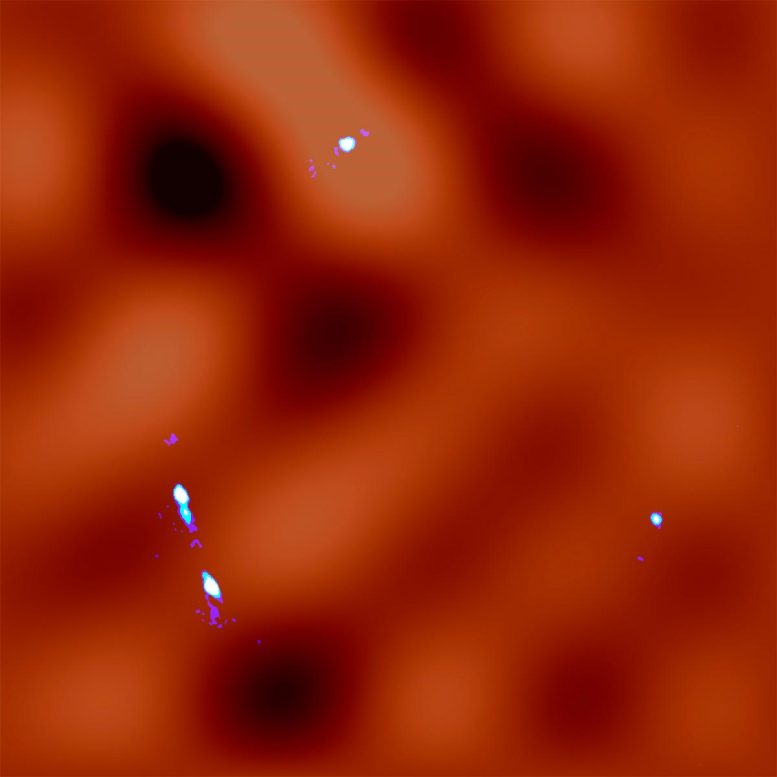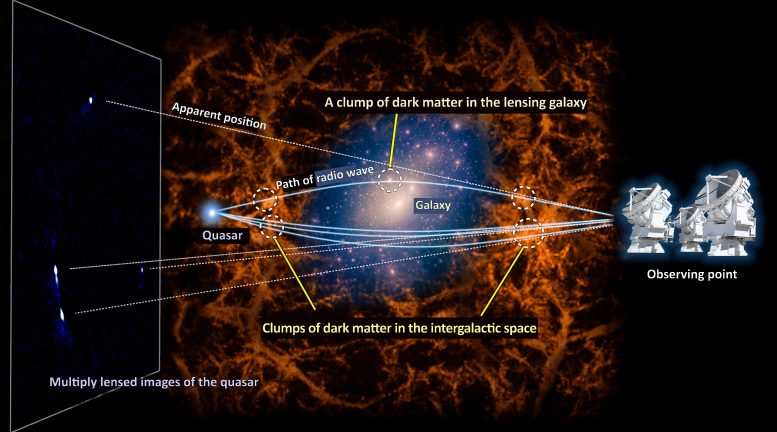
Dark matter fluctuations in the lens system MG J0414+0534. The whitish blue color represents the gravitationally lensed images observed by ALMA. The calculated distribution of dark matter is shown in orange; brighter regions indicate higher concentrations of dark matter and dark orange regions indicate lower concentrations. Credit: ALMA(ESO/NAOJ/NRAO), K. T. Inoue et al.
A team of researchers has used the gravitational lensing of the MG J0414+0534 system, observed with ALMA, to map dark matter distribution in unprecedented detail, confirming theories of cold dark matter and paving the way for further discoveries about the universe’s dominant but elusive component.
New research has revealed the distribution of dark matter in never-before-seen detail, down to a scale of 30,000 light-years. The observed distribution fluctuations provide better constraints on the nature of dark matter.
Mysterious dark matter accounts for most of the matter in the Universe. Dark matter is invisible and makes itself know only through its gravitational effects. Dark matter has never been isolated in a laboratory, so researchers must rely on “natural experiments” to study it.
Gravitational Lensing as a Natural Experiment
One type of natural experiment is a gravitational lens. Sometimes by random chance, two objects at different distances in the Universe will lie along the same line-of-sight when seen from Earth. When this happens, the spatial curvature caused by the matter around the foreground object acts like a lens, bending the path of light from the background object and making a lensed image. However, it is difficult to achieve the high resolution to detect clumps of dark matter which are less massive than galaxies in natural experiments, so the exact nature of dark matter has been poorly constrained.

A conceptual diagram of the gravitational lens system MG J0414+0534. Dark matter associated with the lensing galaxy is shown in pale blue and white. Dark matter in intergalactic space is shown in orange. Solid lines show the actual paths of the radio waves which are bent by gravity. Dotted lines show the apparent observed positions of the lensed images. Credit: NAOJ, K. T. Inoue
A team of Japanese researchers led by Professor Kaiki Taro Inoue at Kindai University used ALMA (Atacama Large Millimeter/submillimeter Array) to study the gravitational lens system known as MG J0414+0534 in the direction of the constellation Taurus. In this system, the foreground object forms not one, but four images of the background object due to the gravitational force of a massive galaxy acting on the light. With the help of the bending effect and their new data analysis method, the team was able to detect fluctuations in the dark matter distribution along the line-of-sight in higher resolution than ever before, down to a scale of 30,000 light-years.
Looking Forward to Future Discoveries
The new constraints provided by the observed distribution are consistent with models for slow moving, or “cold,” dark matter particles.
In the future, the team plans to further constrain the nature of dark matter with additional observations.
For more on this research, see .
Reference: “ALMA Measurement of 10 kpc Scale Lensing-power Spectra toward the Lensed Quasar MG J0414+0534” by Kaiki Taro Inoue, Takeo Minezaki, Satoki Matsushita and Kouichiro Nakanishi, 7 September 2023, The Astrophysical Journal.
DOI: 10.3847/1538-4357/aceb5f









I predicted a stationary galactic scale concentric “dark matter” ripple effect, as an evident quantum gravity feature for compact large masses, over a decade ago.
For that reason and others this page might as well be acting like “kryptonite” for exposing “super” gravity experts around here, who most likely must always pretend to have pressing business elsewhere, probably grading papers poorly.